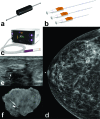Innovations in image-guided preoperative breast lesion localization
- PMID: 29271240
- PMCID: PMC6190760
- DOI: 10.1259/bjr.20170740
Innovations in image-guided preoperative breast lesion localization
Abstract
Screening mammography increases detection of non-palpable breast lesions requiring image-guided localization prior to surgery. Accurate preoperative localization is crucial for successful surgical outcomes. Wire-guided localization is currently the most widely used localization method for non-palpable breast lesions; however, this technique has multiple disadvantages including patient discomfort, possible wire transection and migration, suboptimal surgical incision placement due to wire location and limited scheduling flexibility decreasing operating room efficiency. As a result, promising new techniques including radioactive seed localization, non-radioactive radar localization and magnetic seed localization have been developed as alternatives. In this article, we provide an overview of these techniques and discuss their advantages, drawbacks and currently available outcome data.
Figures




References
-
- Cady B, Stone MD, Schuler JG, Thakur R, Wanner MA, Lavin PT. The new era in breast cancer. Invasion, size, and nodal involvement dramatically decreasing as a result of mammographic screening. Arch Surg 1996; 131: 301–8. - PubMed
-
- Nederend J, Duijm LE, Louwman MW, Groenewoud JH, Donkers-van Rossum AB, Voogd AC. Impact of transition from analog screening mammography to digital screening mammography on screening outcome in The Netherlands: a population-based study. Ann Oncol 2012; 23: 3098–103. doi: 10.1093/annonc/mds146 - DOI - PubMed
Publication types
MeSH terms
Grants and funding
LinkOut - more resources
Full Text Sources
Other Literature Sources
Medical
Research Materials

